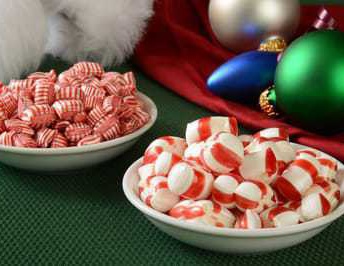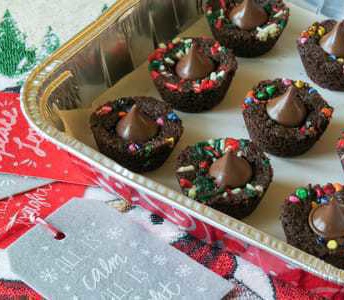
I’m so excited to welcome my first guest blogger, Gigi Stewart, MA of Gluten Free Gigi! Gigi is a writer, recipe developer, and scentist who believes in smart nutrition backed by science. I love that we’ve been able to connect and stay in touch via social media and blogging. Today, Gigi shares her tips on selecting gluten free holiday candies. As you guys know, I love my sweets so this article rings true for me as I’m sure it will for you! I also did a guest blog post on her website so be sure to check them both out! Thanks Gigi!
—
Hi, everyone! I’m Gigi, creator of the GlutenFreeGigi.com, a website filled with gluten-free, allergen-free recipes and loads of my signature Smart Nutrition Backed by Science wellness information. As someone with celiac disease and multiple food allergies, I aim to share valuable information with my readers to help them maintain a positive, balanced lifestyle while navigating a special diet. I’m happy Jackie invited me to share some of my tips with you about choosing gluten-free holiday candies.
Strolling down the candy aisle around Christmas time can be overwhelming even if you don’t have to avoid gluten, but when you do, it can be a serious (and daunting) challenge.
There are many specialty companies making 100% gluten-free candy but what I’m most often asked by those who are new-to-gluten-free is can they still enjoy a favorite mainstream treat, especially around the holidays. Most of us have a special candy we associate with family holidays. Maybe it’s a candy dish full of Hershey’s Kisses® like my grandmother kept filled all season long. Or it could be the soft sugar peppermint sticks my godfather handed out on Christmas Eve.
When the holidays roll around and we want to reach for a taste of nostalgia, it’s good to know the facts on ingredients first.
Many mainstream candy companies share online resources listing their gluten-free offerings. For example, The Hershey Company created a Dietary Needs page. But unless you print each list prior to shopping for your holiday candy, you might find yourself confused over which candy to buy and which to avoid.
Many products are labeled “gluten-free” which means they contain less than 20 parts per million gluten per the FDA gluten-free food labeling law; however, there are some very good products that are 100% gluten-free that are not labeled as such. That may be because the product is naturally gluten-free and the producer never considered changing labels. Those soft peppermint sticks I mentioned earlier are a great example. For as long as the producer (Piedmont Candy Company) of my favorite brand has been in business, their facility has been 100% gluten-free. But it had nothing to do with trying to avoid gluten; it was just that their product naturally contains no gluten and that is all they produce.
But what about when we aren’t sure? The best place to start to figure out for yourself is with the ingredients label.
5 Tips for Finding Safe Gluten-Free Holiday Candy
1 – What to Look for on the Label
If you’re gluten-free, you already know wheat is on the “must avoid” list. Almost all traditional products containing flour as an ingredient contain wheat. While wheat is more common in baked goods, some candies (like licorice) contain wheat. It is used as a binder or thickener in certain candies.
Malt is a common gluten-containing ingredient in candy. Malt is the most common barley ingredient, used as a flavoring and flavor enhancer in a wide range of foods and beverages. In candies, you are likely to see maltose (malt sugar). All forms of barley, including all malt ingredients, contain gluten.
Not as common in candy, but still worth noting are rye and traditionally produced oats. Oats are technically gluten-free, but are often contaminated with gluten from the field where they are grown or from the production process. Oats grown in accordance with a purity protocol that are certified gluten-free are the best option, and still, not all celiac patients can tolerate oats, so keep that in mind.
2 – Other Words for Wheat
There are many varieties and names for wheat: bulgur, couscous, dinkle, durum, einkorn, emmer, Farina®, fu, graham, kamut, seitan, semolina and spelt.
Other common wheat products: wheat berries, wheat germ, wheat germ oil, wheat grass (also called triga), wheat gluten, wheat nut and wheat starch. Again, wheat starch is sometimes used to bind or thicken candies.
3 – Possible Hidden Gluten in Candies
Even when a candy appears straightforward, for example, a chocolate truffle, that doesn’t mean it is. As mentioned before, maltose (malt sugar) is used in some chocolate confections. Candies with crisp rice cereal bits (like a Crunch bar) also contain gluten due to the barley malt in the cereal.
Another issue to be aware of with holiday candy is that while some candies like Reese’s Peanut Butter Cups® are gluten-free, the seasonal shapes (i.e., Christmas Tree Shaped Reese’s) are not. Those products are made from a different recipe than regular Reese’s Cups and contain wheat. This is true of many seasonal and “mini” shaped candies, so ALWAYS read those labels before buying and consuming!
4 – Cross-Contamination Issues
You’re likely familiar with the allergen statements located below or near the ingredients list on food labels. The top eight allergens (wheat, milk, peanuts, tree nuts, eggs, soy, fish, shellfish) must be listed there if contained in the ingredients according to the FDA. Additionally, there are sometimes caution statements about possible cross-contamination with one of those top eight allergens. While gluten is not one of the top eight, wheat is, and these days manufacturers often include gluten in their allergen statement or caution notices on product labels.
A single facility processes multiple products. Depending on those products, that could mean airborne gluten-containing wheat.
Shared equipment is used to process various food items in a manufacturing facility.
5 – Look out for “Re-bagged” Candies
Some candies are re-bagged, meaning purchased in bulk from the producer, then repackaged into smaller packaging. One example of this is Smarties candies from Spangler. Direct from the company, Smarties are gluten-free, however, as the manufacturer points out, the candies are sold in bulk and often re-bagged by sellers, at which time, the candy could come into contact with gluten or other allergens.
Some Tasty Gluten-Free Choices
Lots of mainstream holiday candies are gluten-free, here are a few:
- Most varieties of Hershey’s Kisses (not white chocolate peppermint)
- Plain M&Ms (read label on all packages, as they can be produced in different facilities; Mars)
- All Tootsie Roll brand products
- Lifesavers® Christmas Story Books and Candy Cane Lifesavers® (Wrigley)
- All Jelly Belly Gourmet Jelly Beans
- Red Bird Peppermint Puffs (Piedmont Candy Company)
- Bob’s Candy Canes (Spangler)
- Starburst (Spangler)
- See’s Candies
You might find my 2016 Gluten-Free Christmas Candy List useful, too!
Keep in mind, I’m not advocating we overdo it with sweet treats during the holidays or any time, but I do believe the occasional indulgence, especially during the holidays, is perfectly fine. If you feel the same way, I hope this information helps you make the best choices for your gluten-free diet.
Happy gluten-free holidays!
Gigi
www.GlutenFreeGigi.com
Instagram @glutenfreegigi
Facebook Gluten Free Gigi
Pinterest Gluten FreeGigi
Twitter @glutenfreegigi


























